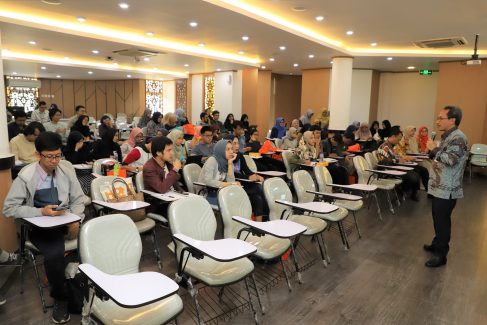Islamic Business Program FEB UI Held Public Lecture on the Implementation of Asset and Liability Management at BRI Syariah
Nino Eka Putra ~ Humas FEB UI
DEPOK – Islamic Business Study Program FEB UI held a Public Lecture by presenting speakers from BRI Syariah Bank practitioners with the theme “Asset & Liability Management (ALMA) in Islamic Banking / Liquidity Risk” and guided by Evony Silvino Violita which took place at the KKI Auditorium, on Thursday (11/28/2019).
BRI Syariah Commercial Business Director, Kokok Alun Akbar explained that BRI Syariah is a subsidiary of Bank BRI with the largest profit income in each of the last 10 years. BRI Syariah (BRI’S) online development is launching a QR code payment and halal travel platform.

ALMA in Islamic banks and liquidity risk is an effort to optimize the bank’s balance sheet structure in such a way as to obtain maximum profit with risks that can be accepted with key words such as management, assets, liabilities, risk, and return. The main pillars of ALMA are infrastructure, policies and processes. Meanwhile, the main functions are liquidity management, foreign exchange management, principals & earnings management, and gap management. In addition, the main risk lies in financing risk, liquidity, yields, exchange rates, contingencies, and gaps.
“The ALMA process focuses on managing exposures arising from the balance sheet and optimizing the trade off between results and risk. Meanwhile, the objectives of the ALMA carried out by each bank in general are reasonable bank growth, maximum income / profit, maintaining adequate liquidity, establishing possible risk reserves, maintaining / maintaining public funds entrusted through reasonable / wise bank activities, and meet the community’s need for financing, “he said.
On the other hand, liquidity management is all activities of managing the source of funds and the use of short-term funds aimed at maintaining bank liquidity as a whole to support the bank’s operational activities as well as meeting regulatory provisions (BI or OJK).
“Thus, liquidity management is like a calm but carried away which can cause bank collapses, it needs to be managed. Liquidity risk occurs when trust in the rupiah decreases, the purchase of dollars (USD) or the sale of rupiah assets is crowded, the occurrence of rush on banks, “he explained.
The things done in identifying liquidity risk are identifying data & information, identifying nostro accounts, preparing daily cash flow, if there is negative cash flow in a certain period then it must control liquidity risk that occurs.
Therefore, in liquidity management there is a conflict of interest between maintaining liquidity and getting the highest profit. “Therefore, it is necessary to apply ALMA and optimum liquidity management,” he concluded. (Des)




















